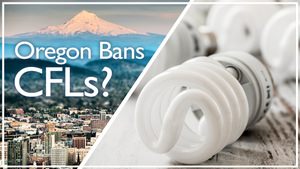In January of 2025, Minnesota will be banning the sale and distribution of most kinds of fluorescent light bulbs. What does this mean?

Over the course of the next year, the state of Minnesota is banning the sale, manufacturing and distribution of fluorescent light bulbs. Minnesota isn’t the first state to do this – and certainly won’t be the last. Last year, we spotlighted Oregon as they banned fluorescent light bulbs... now, it's time to cover the Star of the North.
Here, I’ll cover everything you need to know about the ban and offer some helpful suggestions for how to approach replacing your fluorescent lights - whether or not you live in Minnesota. :)
So, without further ado…
Action, camera… lights!
Why Are They Banning Fluorescent Bulbs?
Light bulb bans have been rolling out on a state-by-state basis for a number of years now - the most infamous of which was the 2023 country-wide ban on incandescent light bulbs. This entailed permanently halting the manufacturing and distribution of these light bulbs – affecting mainline retailers like us and our contemporaries in the lighting industry. This policy was implemented and overseen by the Government's Department of Energy.
Both bans on incandescent and fluorescent technology can be stripped back to two motivating factors:
Energy Efficiency
Along with most types of traditional lighting methods, fluorescent bulbs use a significant amount of energy compared to the more contemporary alternatives like LEDs.
Limiting the Use of Hazardous Materials
The use of toxic materials in fluorescent bulbs is another reason they’re getting phased out. They require the use of a toxic material (mercury) to function properly. Thankfully, when contained to the glass enclosure of a light bulb, mercury poses less of a threat.
That said, do you know anyone that’s never broken a light bulb? ;)
Which Fluorescent Light Bulbs Are Getting Banned in Minnesota... and When?
As is the case with most light bulb bans, this one will be happening incrementally over the course of about a year. The first wave of the ban will look like this:
Effective January 1st, 2025, the sale and distribution of Compact Fluorescent Lights (CFLs) with a Screw-Base or Bayonet-Base will not be permitted.
Those look something like the following:

The second wave of the ban will look like this:
Effective January 1st, 2026, the sale and distribution of Linear or Compact Fluorescent Lights (CFLs) with a Pin-Base will not be permitted.
Those look something like the following:

Which States Have Already Banned Fluorescent Light Bulbs?
Here, we’re mostly focusing on Minnesota – home of LightBulbs.com / Service Lighting. That said, we’re not the only state to do this – and we sure won’t be the last.
Other states that have begun to roll out a ban on fluorescent technology in some capacity are as follows:
California
Colorado
Hawaii
Illinois
Maine
Maryland
Massachusetts
Nevada
New Jersey
New York
Oregon
Rhode Island
Vermont
Washington
Washington D.C.
Oh, and Canada. Just all of Canada.
What Light Bulbs Can I Use Instead of Fluorescents?
Great question, I thought you’d never ask! :)
For the vast majority of traditional lamps like incandescents, halogens, and fluorescents, there are suitable LED replacements. LEDs are becoming more and more commonplace – and emulate the light from natural filaments seamlessly.
Take a look at the photo below.
Can you guess which one of these light bulbs uses LED technology and which one uses incandescent technology?

Well, actually... it was a trick question.
They’re both LEDs.
That's right. The one on the left is WL43697, and the one on the right is SL40726. Don't believe me? Feel free to get your own, or see below for more options for replacing more specific kinds of lights with LEDs:
Here, we have LED Replacements for Pin-Base Linear Fluorescent Tubes.
Here, we have LED Replacements for Pin-Base CFLs.
Here, we have LED Replacements for Screw-Base CFLs.
Conclusion
Well, there you have it - another day, another light bulb ban. Thanks for reading, and thanks for letting us help you navigate this transition. We know it can be confusing and even outright inconvenient to have to worry about switching light bulbs - we wish it wasn't as complicated as it is. But, these are necessary steps toward a better future for all of us - so, thank you for playing your part. :)






